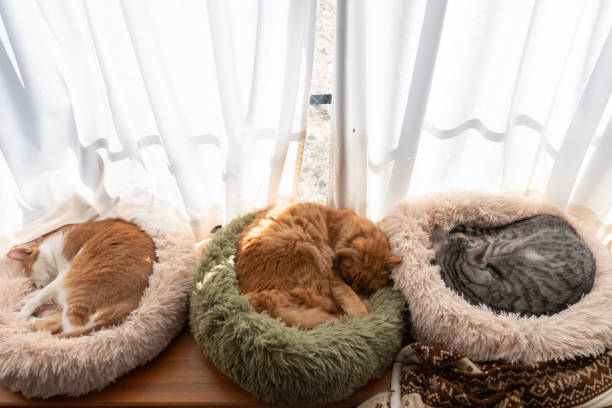
Snuggle Sanctuary: How to Create a Cozy Sleeping Space That Transforms Your Pet’s Rest
Discover expert tips and science-acked strategies to design a comfortable, secure sleeping area that enhances your pet’s health, happiness, and quality of rest every single night.
🐶 Pet Star
31 min read · 4, Jul 2025

Introduction: The Importance of a Cozy Sleeping Area for Pets
Pets are more than just companions—they’re family. Their health and happiness are intimately linked to their environment, especially their sleeping space. Just like humans, pets need quality rest to maintain physical health, regulate emotions, and support cognitive functions.
Creating a cozy sleeping area tailored to your pet’s specific needs can significantly improve their sleep quality, leading to better behavior, stronger immunity, and enhanced longevity. Yet many pet owners underestimate the impact of a proper resting environment.
In this article, we’ll explore how to design the perfect sleeping area for your pet, backed by expert advice and scientific insights. From choosing the right bedding to understanding your pet’s unique preferences, you’ll learn everything you need to ensure your furry friend sleeps soundly and wakes up refreshed.
Why Quality Sleep Matters for Pets
The Science of Animal Sleep
Sleep isn’t just downtime; it’s a vital biological process. Dogs, cats, and other pets require different amounts and types of sleep compared to humans, but all rely on restful sleep for tissue repair, memory consolidation, and immune function.
- Dogs sleep 12-14 hours daily on average, with puppies and seniors needing even more.
- Cats are true sleep champions, often clocking 13-16 hours of sleep each day.
- Lack of quality sleep in pets can manifest as irritability, hyperactivity, anxiety, or physical health issues.
Veterinarian Dr. Lisa Freeman notes:
“Just like us, pets need a calm and comfortable place to rest. Disruptions or poor-quality bedding can affect their sleep cycle and overall wellness.”
Understanding Your Pet’s Sleeping Habits
Observe and Adapt
Every pet has unique sleeping preferences based on breed, age, health, and personality. Some dogs prefer to curl up in enclosed spaces, while others stretch out comfortably. Cats often seek warm, elevated spots or cozy hideaways.
Key factors to consider:
- Breed tendencies: For example, Huskies with thick coats may prefer cooler areas, while smaller breeds like Chihuahuas love warmth.
- Age and health: Older pets may require orthopedic beds for joint support.
- Behavior: Shy pets often prefer secluded spaces, whereas social pets want their beds near family activity.
Example:
A Labrador Retriever might enjoy a spacious, plush bed in a living room corner, while a timid cat may sleep best in a covered cat cave placed in a quiet bedroom.
Choosing the Right Location for Your Pet’s Sleeping Area
Quiet, Safe, and Comfortable
Location is key. Pets need a sleeping area that’s:
- Free from loud noises and household traffic.
- Away from drafts or direct sunlight.
- Easily accessible for pets with mobility issues.
Tips for ideal placement:
- Use bedrooms or less busy rooms to reduce disturbances.
- Avoid placing beds near heating vents or windows.
- Consider pet behavior—some dogs want to sleep near owners, others prefer solitude.
Research Insight:
A 2021 study in Applied Animal Behaviour Science found pets sleeping near their owners experienced lower anxiety levels and better sleep quality, but only if the sleeping environment was calm.
Selecting the Perfect Bedding: Comfort Meets Function
Material Matters
Bedding choice affects temperature regulation, comfort, and hygiene. Consider:
- Memory foam beds for older pets with arthritis.
- Orthopedic beds providing joint support.
- Soft, washable fabrics for easy cleaning.
- Heating pads or cooling mats depending on climate and pet needs.
Durability vs. Comfort:
Pets can be tough on beds—chewing, scratching, or digging. Look for materials that balance softness with durability.
Creating Warmth and Security: The Psychology of Cozy
Enclosed Spaces and Soft Textures
Pets feel safer in spaces that mimic dens. Beds with raised edges, blankets, or covered designs appeal to their instinctual need for security.
- Covered beds or “pet caves” provide a private retreat.
- Soft blankets add warmth and tactile comfort.
- Layering bedding allows pets to adjust warmth easily.
Veterinary behaviorist Dr. Sarah Ellis shares:
“Providing a den-like environment reduces stress and helps pets fall asleep faster.”
Temperature Control: Keeping Your Pet Comfortable Year-Round
Managing Heat and Cold
Pets can’t regulate temperature like humans. Proper temperature management in their sleeping area is vital.
- Use cooling mats in summer to prevent overheating.
- Offer heated beds or pads in winter for warmth.
- Place beds away from drafty areas or direct sunlight to avoid discomfort.
Maintaining Cleanliness: Hygiene for Healthier Sleep
Regular Cleaning Routines
Clean bedding reduces allergens, bacteria, and odors—key for pets prone to skin issues or respiratory problems.
- Wash beds weekly with pet-safe detergents.
- Use removable, machine-washable covers.
- Vacuum or shake out bedding regularly.
Incorporating Scent and Familiarity: Comfort Through Smell
The Power of Familiar Scents
Pets rely heavily on scent for comfort. Including an item with your scent or your pet’s own scent in their sleeping area can reduce anxiety.
- Use unwashed blankets or your worn t-shirt.
- Consider calming sprays with pheromones approved by vets.
Addressing Special Needs: Senior Pets and Those with Health Conditions
Tailoring the Space
Older pets or those with arthritis, mobility issues, or anxiety need specialized bedding and locations.
- Orthopedic foam supports aching joints.
- Beds with low entry points improve accessibility.
- Calming environments reduce stress for anxious pets.
Tips for Encouraging Your Pet to Use Their Sleeping Area
Introducing the Space Gradually
Many pets may initially resist using a new sleeping area simply because it’s unfamiliar. Patience and positive associations are key.
- Start by placing their favorite blanket or toy in the bed to draw them in.
- Use treats or praise whenever your pet approaches or settles in the bed.
- Avoid forcing your pet into the bed, which can create negative associations.
- Encourage naps during quiet times, making the bed a calm, inviting place.
Behaviorist Dr. Emma Brooks advises:
“Consistency is vital. If your pet’s bed becomes associated with calmness, safety, and rewards, they’ll be more inclined to use it regularly.”
Make It Part of Their Routine
Pets thrive on routine. Incorporate their sleeping area into daily rituals such as bedtime or after exercise. For example, gently guiding them to their bed after playtime or dinner can build a comforting habit.
Recognizing When Your Pet’s Sleeping Area Needs an Update
Signs to Watch For
Even the coziest sleeping spot will eventually need refreshing. Be attentive to:
- Wear and tear: Flattened or torn bedding can reduce comfort.
- Odors or stains: May indicate the need for thorough cleaning or replacement.
- Behavioral cues: If your pet avoids their bed, it might be uncomfortable or no longer suitable.
- Physical changes: Senior pets or those with health issues may require beds with better support or accessibility.
Veterinarian Dr. Michael Rodriguez states:
“A pet’s sleeping needs evolve over time. Regularly assessing their bed’s condition ensures they continue to rest well.”
The Role of Lighting and Noise in Creating a Restful Pet Environment
Creating a Calm Atmosphere
Environmental factors like lighting and noise can significantly influence your pet’s ability to relax.
- Dim lighting: Similar to humans, pets respond well to low light when sleeping. Avoid placing beds in brightly lit or glaring spaces.
- Sound control: Loud noises or constant background sounds (e.g., TV, vacuum) may disturb your pet’s rest.
- Consider using white noise machines or calming music designed for pets to mask disruptive sounds.
A 2019 study in Frontiers in Veterinary Science found that dogs exposed to calming music showed reduced stress levels and improved sleep quality.
Creating a Multi-Purpose Sleeping Area for Pets Sharing Spaces
Managing Shared Sleeping Arrangements
If you have multiple pets or live in a small space, you might need to create sleeping areas that accommodate several animals or coexist with human sleeping spaces.
- Provide individual beds for each pet to reduce competition and stress.
- Position beds at a comfortable distance to respect territorial instincts.
- Use different textures or colors to help pets identify their own space.
- For pets sharing beds, monitor interactions to ensure peaceful coexistence.
Outdoor Sleeping Areas: Designing Cozy Spaces for Pets Who Spend Time Outside
Safety and Comfort in the Open Air
Some pets, particularly certain dog breeds or outdoor cats, prefer spending time or sleeping outside. Their outdoor sleeping areas require special considerations:
- Weather protection: Use insulated dog houses or covered cat shelters to shield pets from rain, wind, and cold.
- Elevated bedding: Keeps pets off cold or damp ground.
- Secure locations: Ensure the area is safe from predators and hazards.
- Appropriate bedding: Waterproof, durable, and easy-to-clean materials work best.
Research by the American Veterinary Medical Association emphasizes the importance of shelter quality in outdoor pet welfare.
Common Mistakes to Avoid When Creating Your Pet’s Sleeping Area
Pitfalls That Can Undermine Comfort
- Placing the bed in high-traffic or noisy areas.
- Using beds too small or too large for your pet.
- Ignoring your pet’s preferences or behavioral cues.
- Neglecting to maintain cleanliness.
- Overheating or chilling the sleeping space.
Avoiding these mistakes ensures your pet’s sleeping environment truly promotes rest and relaxation.
Conclusion: Prioritizing Comfort for Your Pet’s Best Rest
Creating a cozy sleeping area for your pet is much more than simply placing a bed on the floor. It’s about understanding their unique needs, behaviors, and preferences to design a space that promotes restful, restorative sleep. Quality sleep supports your pet’s physical health, emotional well-being, and longevity, making it a crucial component of responsible pet care.
By selecting the right location, comfortable bedding, and managing environmental factors like temperature, noise, and lighting, you create a sanctuary that encourages relaxation and security. Paying attention to cleanliness and regularly updating your pet’s sleeping area as they age or their needs change ensures continued comfort and health benefits.
Incorporating elements such as familiar scents and cozy, enclosed spaces taps into your pet’s natural instincts, reducing anxiety and improving sleep quality. Modern innovations like heated beds, cooling mats, and sleep monitoring technology offer additional tools to optimize your pet’s rest.
Whether your pet sleeps indoors, outdoors, or shares space with family members, creating an inviting and personalized sleeping environment fosters a happier, healthier companion. As pets depend on us for their care, investing time and effort into designing their sleeping area is one of the simplest yet most impactful ways to enhance their quality of life.
Ultimately, a thoughtfully crafted sleeping space not only improves rest but strengthens the bond between you and your beloved pet—ensuring many cozy nights and joyful mornings together.
Q&A: Essential Insights on Creating Cozy Sleeping Areas for Pets
Q1: What factors should I consider when choosing my pet’s sleeping area?
A1: Consider quietness, temperature, accessibility, safety, and proximity to your pet’s favorite spots or family areas.
Q2: How often should I clean my pet’s bedding?
A2: Ideally, wash bedding weekly with pet-safe detergents and vacuum regularly to reduce allergens and odors.
Q3: Are orthopedic beds necessary for all pets?
A3: No, they’re most beneficial for older pets or those with joint issues, but younger pets typically prefer softer or standard beds.
Q4: Can outdoor pets have comfortable sleeping areas?
A4: Yes, with insulated shelters, waterproof bedding, and protection from elements, outdoor pets can have cozy spots too.
Q5: How do I encourage my pet to use their new bed?
A5: Use treats, familiar toys, positive reinforcement, and avoid forcing them—make the bed inviting and part of their routine.
Q6: Does lighting affect my pet’s sleep?
A6: Yes, pets prefer dim or natural light for sleep, and harsh lighting can disrupt their rest cycles.
Q7: What role does scent play in pet comfort?
A7: Familiar scents from you or their belongings provide security and reduce anxiety, enhancing sleep quality.
Q8: Can pets share sleeping areas?
A8: They can, but individual beds are recommended to reduce stress and territorial disputes.
Q9: How do I know if my pet’s bed needs replacing?
A9: Signs include flattening, odor buildup, stains, or if your pet avoids using it.
Q10: Are there technological tools to improve pet sleep?
A10: Yes, heated beds, cooling mats, sleep trackers, and calming sound devices are increasingly available for pets.
Similar Articles
Find more relatable content in similar Articles

How Climate Change Affects Wild and Domestic Animals...
Climate change is dramatically.. Read More

The Growing Trend of Therapy and Emotional Support Ani..
Exploring the remarkable rise .. Read More

Pets and Mental Health: The Science Behind Emotional H..
Discover the profound impact o.. Read More

How Pets Strengthen Family Bonds...
Pets are more than just compan.. Read More
Explore Other Categories
© 2024 Copyrights by rPets. All Rights Reserved.